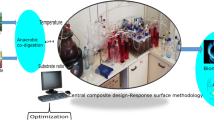Abstract
Biohydrogen is a clean source of energy that produces no harmful byproducts during combustion, being a potential sustainable energy carrier for the future. Therefore, biohydrogen produced by anaerobic bacteria via dark fermentation has attracted attention worldwide as a renewable energy source. However, the hydrogen production capability of these bacteria depends on major factors such as substrate, iron-containing hydrogenase, reduction agent, pH, and temperature. In this study, the response surface methodology (RSM) with central composite design (CCD) was employed to improve the hydrogen production by an anaerobic bacterial strain isolated from animal waste in Phu Linh, Soc Son, Vietnam (PL strain). The hydrogen production process was investigated as a function of three critical factors: soluble starch concentration (8 g L−1 to 12 g L−1), ferrous iron concentration (100 mg L−1 to 200 mg L−1), and l-cysteine concentration (300 mg L−1 to 500 mg L−1). RSM analysis showed that all three factors significantly influenced hydrogen production. Among them, the ferrous iron concentration presented the greatest influence. The optimum hydrogen concentration of 1030 mL L−1 medium was obtained with 10 g L−1 soluble starch, 150 mg L−1 ferrous iron, and 400 mg L−1 l-cysteine after 48 h of anaerobic fermentation. The hydrogen concentration produced by the PL strain was doubled after using RSM. The obtained results indicate that RSM with CCD can be used as a technique to optimize culture conditions for enhancement of hydrogen production by the selected anaerobic bacterial strain. Hydrogen production from low-cost organic substrates such as soluble starch using anaerobic fermentation methods may be one of the most promising approaches.
Similar content being viewed by others
References
D. Das and T.N. Veziroglu, Int. J. Hydrogen Energy 33, 6046 (2008).
J.Y. Lee, T. Miyahara, and T. Noike, Bioresour. Technol. 80, 227 (2001).
L. Singh and Z.A. Wahid, Int. J. Energy Res. 39, 215 (2015).
H. Yokoi, R. Maki, J. Hirose, and S. Hayashi, Biomass Bioenergy 22, 389 (2002).
Design-Expert 7.1 for Windows-Software for Design of Experiments (DOE)-Stat-Ease Inc., Minneapolis, USA (2007).
C. Huoqing, M.A. Xiaoxuan, F. Daidi, L. Yane, G. Peng, and Y. Chanyuan, Chin. J. Chem. Eng. 18, 681 (2010).
D.M. Bao, J.H. Su, and T.W. Tan, Fuel 112, 38 (2013).
X. Zhao, D. Xing, B. Liu, L. Lu, J. Zhao, and N. Ren, Int. J. Hydrogen Energy 37, 13711 (2012).
Y. Song and B.E. Logan, Water Res. 38, 1626 (2004).
M. Taherdanak, H. Zilouei, and K. Karimi, Int. J. Hydrogen Energy 40, 12956 (2015).
M.U. Yang, J.Z. Xian, and Q.Y. Han, Int. J. Hydrogen Energy 34, 7959 (2009).
G. Liu and G. Shen, J. Biosci. Bioeng. 4, 251 (2004).
J. Wang and W. Wan, Int. J. Hydrogen Energy 33, 1215 (2008).
J. Wang and W. Wan, Int. J. Hydrogen Energy 34, 235 (2008).
Q.W. Guo, Q.N. Ren, J.X. Wang, S.W. Xiang, J. Ding, Y. You, and F.B. Liu, Bioresour. Technol. 100, 1192 (2009).
Y.J. Yoo, J. Hong, and R.T. Hatch, Biotechnol. Bioeng. 30, 147 (1987).
H. Yang and J. Shen, Int. J. Hydrogen Energy 31, 2137 (2006).
Z. Yuan, H. Yang, X. Zhi, and J. Shen, Int. J. Hydrogen Energy 22, 6535 (2008).
T. Zhang, H. Liu, and H.P.F. Herbert, J. Environ. Manag. 69, 149 (2003).
Acknowledgements
The authors acknowledge financial support from the Department of Petroleum Microbiology, Institute of Biotechnology, Vietnam Academy of Science and Technology. We would like to express our thanks for equipment support by the World University Service (WUS) within the scope of the APA support “Workplace Equipment Subsidies for Experts from Developing Countries” (APA2738) and the World Academy of Science for the advancement of science in developing countries (TWAS) (Research Grant No. 12-098 RG/BIO/AS_I).
Author information
Authors and Affiliations
Corresponding author
Rights and permissions
About this article
Cite this article
Kieu, H.T.Q., Nguyen, Y.T., Dang, Y.T. et al. Use of Response Surface Methodology to Optimize Culture Conditions for Hydrogen Production by an Anaerobic Bacterial Strain from Soluble Starch. J. Electron. Mater. 45, 2632–2638 (2016). https://doi.org/10.1007/s11664-016-4447-z
Received:
Accepted:
Published:
Issue Date:
DOI: https://doi.org/10.1007/s11664-016-4447-z




